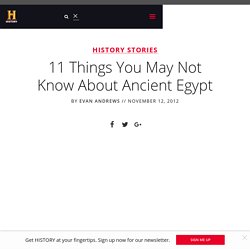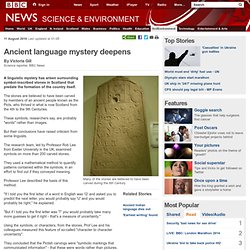

The Oak Island Money Pit. Is a pirate treasure buried in this mysterious pit in Nova Scotia?

The Mystery of the Vitrified Forts. About sixty prehistoric stone forts in Scotland have vitrified walls, where the stone was melted into glass.

How was it done? By Brian Dunning, Skeptoid Podcast Episode 326, September 04, 2012 For over 250 years, archaeologists studying ancient Scottish ruins have reported a type of construction said to defy explanation. About sixty of these rough stone wall enclosures have been found throughout Scotland, and even a few scattered across mainland Europe. Most are prehistoric.
Stories of primitives possessing advanced technologies are not new here on Skeptoid. Not only does that usually turn out to be factually wrong, it also deprives us of whatever the truly fascinating question is — and the answer, assuming we have one yet; and we don't always. 11 Things You May Not Know About Ancient Egypt — HISTORY Lists. Ancient Egypt stood as one of the world’s most advanced civilizations for nearly 3,000 years and created a culture so rich that it has spawned its own field of study.

But while Egyptian art, architecture and burial methods have become enduring objects of fascination, there is still a lot you probably don’t know about these famed builders of the pyramids. From the earliest recorded peace treaty to ancient board games, find out 11 surprising facts about the Gift of the Nile. Along with King Tut, perhaps no figure is more famously associated with ancient Egypt than Cleopatra VII. But while she was born in Alexandria, Cleopatra was actually part of a long line of Greek Macedonians originally descended from Ptolemy I, one of Alexander the Great’s most trusted lieutenants. The Ptolemaic Dynasty ruled Egypt from 323 to 30 B.C., and most of its leaders remained largely Greek in their culture and sensibilities.
Neanderthals Died Out Earlier Than Thought. Neanderthals may have died out earlier than before thought, researchers say.

These findings hint that Neanderthals did not coexist with modern humans as long as previously suggested, investigators added. Modern humans once shared the planet with now-departed human lineages, including the Neanderthals, our closest known extinct relatives. However, there has been heated debate over just how much time and interaction, or interbreeding, Neanderthals had with modern humans. The Plague Doctor’s Garb. Indigo may have thought he was just a man in an unpainted Venetian nose mask this Halloween.

But in fact, he was following in the footsteps of Medieval Europe’s finest Plague Doctors. Behold! Considered an early form of hazmat suit, a plague doctor’s clothing consisted of: •A wide-brimmed black hat worn close to the head. At the time, a wide-brimmed black hat would have been identified a person as a doctor, much the same as how nowadays a hat may identify chefs, soldiers, and workers. New "Hobbit" Human Bones Add to Evidence, Oddity.
October 12, 2005 The "hobbits" are real.

NOVA (PBS) - Mysterious Mummies of China (1998) Top 10 Female Adventurers. Our World When we think of adventurers and explorers it is common to think of men, bearded and grim, setting out in search of new lands or excitement.

However, history is littered with women who have bucked the trend of staying at home and gone on adventures. Here are ten women who traveled the world and led adventurous lives, because they wanted to expand their horizons, earn money, or simply because boredom was not their style. Lady Hester Stanhope Lady Hester was born into the heart of the English establishment, daughter of the 3rd Earl Stanhope and niece to the future Prime Minister, Pitt the Younger. Annie Smith Peck Peck achieved academic success in her twenties as she received degrees in philology and showed a particular aptitude for ancient Greek. Gudridur (or Guðríður) was born around 980AD in Iceland, and her life story comes to us from the great Icelandic sagas.
Pictish beast intrigues Highland archaeologists. 14 September 2011Last updated at 10:11 By Steven McKenzie BBC Scotland Highlands and Islands reporter A Pictish symbol stone built into the wall of a Highland farm building has been recorded by archaeologists.

The markings show a beast, crescent, comb and mirror. Archaeologist Cait McCullagh said it was a mystery how it had taken until this year for the stone to be officially recorded. She said it also suggested that more Pictish stones have still to be documented on the Black Isle where the beast was recorded. Pictish Carvings May Be Written Language. 11 August 2010Last updated at 01:05 By Victoria Gill Science reporter, BBC News Many of the stones are believed to have been carved during the 6th Century A linguistic mystery has arisen surrounding symbol-inscribed stones in Scotland that predate the formation of the country itself.

The stones are believed to have been carved by members of an ancient people known as the Picts, who thrived in what is now Scotland from the 4th to the 9th Centuries. These symbols, researchers say, are probably "words" rather than images. Archeology News. Ancient rock art uncovered in the Scottish Highlands. Seven deep mysteries of history - Technology & science - Science. Top 10 Most Overlooked Mysteries in History. Mysteries Over the last few months we have gone through 30 of the worlds greatest mysteries but what we haven’t covered are ancient mysteries.

This list aims to put that right! Here are ten great unsolved mysteries of science. National Geographic News. October 4, 2012 The suspected burial site and remains of a powerful Maya ruler have been unearthed in Guatemala, archaeologists say. October 3, 2012 A new, tiny dinosaur likely used its self-sharpening teeth against competitors, not prey, a new study suggests September 27, 2012. Warrior Women of Eurasia. The warrior women known to ancient Greek authors as Amazons were long thought to be creatures of myth. Now 50 ancient burial mounds near the town of Pokrovka, Russia, near the Kazakhstan border, have yielded skeletons of women buried with weapons, suggesting the Greek tales may have had some basis in fact. Nomads known as the Sauromatians buried their dead here beginning ca. 600 B.C.; according to Herodotus the Sauromatians were descendants of the Amazons and the Scythians, who lived north of the Sea of Azov.
After ca. 400 B.C. the Pokrovka mounds were reused by the Sarmatians, another nomadic tribe possibly related to the Sauromatians. In general, females were buried with a wider variety and larger quantity of artifacts than males, and seven female graves contained iron swords or daggers, bronze arrowheads, and whetstones to sharpen the weapons. TudorHistory.org.